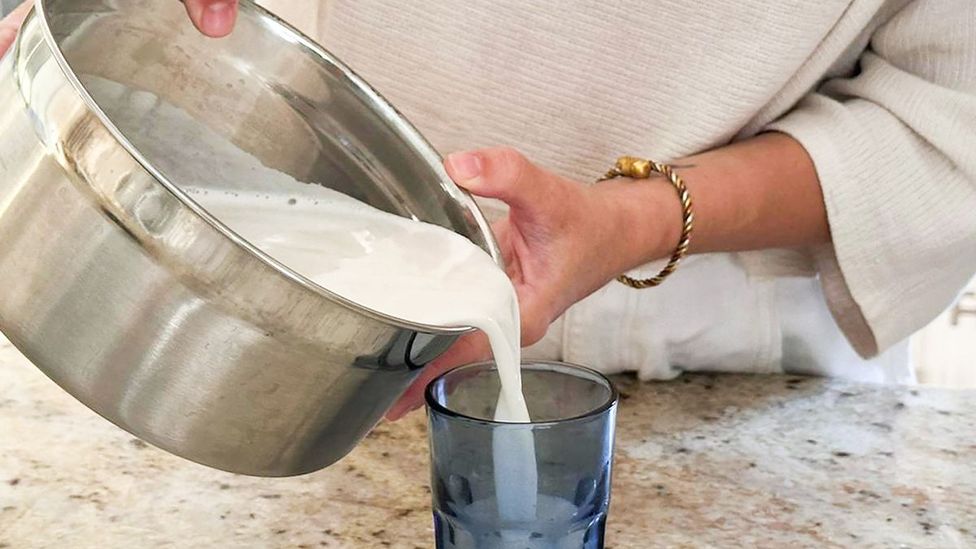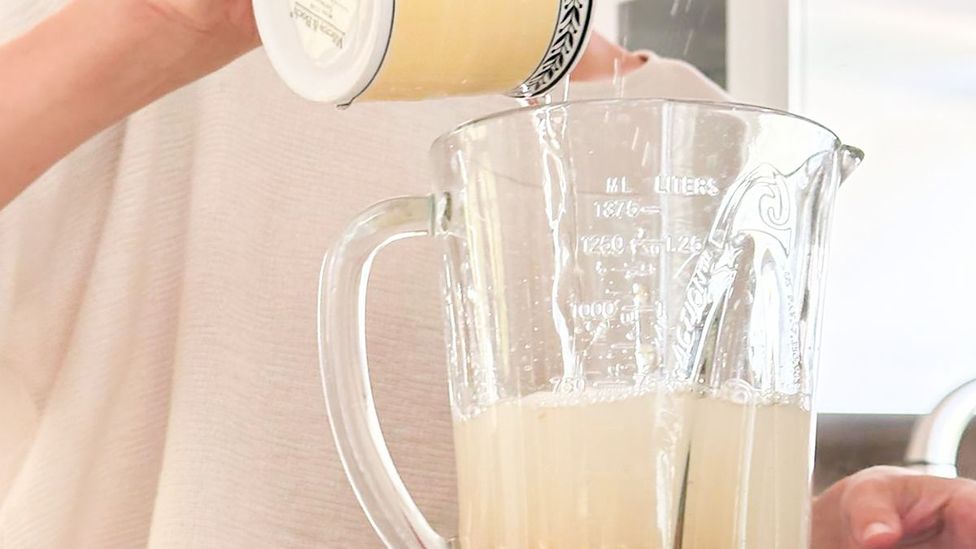I made my own plant-based milk to see if it was cheaper
Plant-based milks have skyrocketed in popularity. But they’re still more expensive to buy than cow’s milk. Lucy Sherriff explores if it’s cheaper just to make her own.
I
I often like to say that I was drinking plant-based milks before it was cool. I’ve had a dairy allergy my entire life, but it used to be pretty hard to find dairy-free alternatives – the only option I had for my morning cereal was a particular brand of soya milk – a thick and slightly sweet grey liquid. It didn’t bother me because I never knew any different.
But how times have changed! The choice of plant milks is now intimidatingly large. Along with their popularity has come controversy too, including an EU-wide ban on giving products dairy-like names.
This popularity is partly driven by consumers’ growing preference for more sustainable food and drink choices. “They’re attractive to people who are concerned about climate change and want to lower the carbon footprint of their diets,” says Aviva Musicus, adjunct assistant professor of nutrition at Harvard’s T H Chan School of Public Health.
Producing a glass of dairy milk results in almost three times more greenhouse gas emissions than any plant-based milk and it uses nine times more land, a 2018 study found.
Sign up to Future Earth
Despite their explosion in popularity, they remain substantially more costly compared to dairy milk. Coffee shops often still charge extra money for dairy-free cappuccinos, and in US supermarkets plant-based milk costs an average of $7.27 (£5.73) a gallon compared to $4.21 (£3.32) a gallon for cow’s milk. (This is in part due to dairy farms having an exceptionally efficient supply chain simply because they’ve been around for so long).
And just because they don’t come from a cow doesn’t mean plant-based milks have a low impact on the environment. “Not all plant-based diets conferred the same health and environmental benefits,” says Musicus, who conducted research on the impacts of plant-based diets.
Almond milk, which is the favourite dairy-free option in the US, has a particularly bad rep. California produces 80% of the world’s almonds and one single almond grown in the state uses 4.6 litres (one gallon) of water. The way almonds are conventionally farmed is also bad for bees. There are also problems when it comes to rice and coconut milk. Rice is a water-guzzling crop, and there can be ethical problems in the coconut supply chain.
So it’s over to oat, hemp and soy, which are all more environmentally friendly options.
But our dietary choices are partly influenced by cost, and if plant-based milks cost more because of the process and packaging involved, then could the problem be solved by just making it ourselves? I set myself this sustainability challenge and was surprised to find that evenwhen making milk at home worked out to be more expensive than buying milk in store, I actually really enjoyed doing it – and it was incredibly easy. I enjoy being in control of where my food comes from and what goes into it – and this felt like one step closer to that.

I tried making oat, soy and hemp milk – the three most environmentally-friendly plant-based milks (Credit: Lucy Sherriff)
The wild card: hemp
I decided to experiment with the poster child of the hippie community: hemp. It took a little extra effort to source – I had to go to a big supermarket rather than my local one – so when it comes to convenience, hemp is not your friend. I’ve always found hemp milk to be watery with a strange aftertaste so I was curious to see if I could get a better flavour by making it at home.
The answer was, not really. Next time I’ll try adding a dash of vanilla extract and a couple of dates to balance the earthy nutty taste. But it was very easy to make – unlike most nuts, no straining was needed. I added the seeds, water and salt to the blender and whizzed it for one minute.
You might also like:
- Squirrel and Japanese knotweed: the pests on the menu
- The untraceable ingredients in skincare products
- Plastic or paper: the straw debate
The cost? The 32 fluid oz (950ml) of hemp milk cost me about $6 (£4.73). To make this amount of hemp milk, you need 4oz (113g) of hulled hemp seeds, which costs $4.50 (£3.54). So, in this case, it does usually work out cheaper to make your own – especially if you buy the seeds in bulk.
The tastiest one: almonds
I didn’t go out and buy any almonds – they cost about $12 for a 10oz (280g) bag – as I felt using what I had in the cupboard was in the true spirit of sustainability. They were roasted, which added an extra je ne sais quoi. I had to soak the almonds in water for a minimum of six hours, so they went in the fridge overnight. The next day I blended the soaked nuts and water for a couple of minutes. Then I had to squeeze my nuts. The recipe called for a nut bag, which I do not own, so I settled for kitchen towel. I squeezed the mixture through the kitchen paper, and it got messy. Next time I’ll invest the couple of dollars to buy one.
The almonds made just under 700ml (23floz) of milk. The cheap almond milk costs about $4 (£3.15) for 32floz (950ml), the fancier stuff comes in at $7 (£5.51) for 28floz (829ml) so it’s decidedly not cheaper to make your own. Although it is far tastier than the milk I buy from the store – it was richer and didn’t have this weird aftertaste that I find most almond milk has.
Trusty and reliable: oat milk
This is the one that I was most looking forward to because my household gets through oat milk by the gallon. And I don’t like that a lot of oat milks use xanthan gum or oil – the thought of pouring oil over my cereal weirds me out – in their recipes to get the milk to that creamy texture.
I did a lot of research on this one because I had heard horror stories of gloopy slime. Oats are sensitive. Rolled oats must be used – none of those quick cook or steel cut types. And the key for the perfect texture is ice cold water – heat makes oats starchy and gummy. There’s no soaking involved, and you actually shouldn’t wring oats out like one does with almonds – that’s how they get slimy and grainy. And don’t over blend! Just 30 seconds should be enough. I didn’t need a nut bag, I used a sieve and it worked just fine.

You need to add ice cold water to make your own tasty oat milk (Credit: Lucy Sherriff)
The organic oats I buy cost $11 (£8.7) for 16oz (450g). This recipe called for 4oz (113g) of oats that made almost 24oz (710ml) of milk (you do lose some in the straining process). The oat milk I buy costs $6 (£4.73) for 64floz (1.8l), so it’d cost me $8.25 (£6.5) to make the same amount. It wasn’t cheaper to make it myself, but I enjoyed using organic oats and controlling what went into the milk. I liked the result so much I even made a second batch, this time with dates – and then another load with a pinch of salt. My favourite was the final sweet-and-salty combination of dates and salt. I have ambitious goals of branching out into chocolate or vanilla oat milk.
I’ll admit it was a fun experiment, and I very much enjoyed tailoring the taste with pinches of salt, or a couple of dates here and there. I love cooking though, and as it was an experiment it didn’t feel like a chore. It’s also nice to know that if I bought in bulk I would be saving on packaging and I’m definitely open to experimenting with other “milks”. Perhaps I’ll try peas next time – although I’ve heard pea milk tastes rather grassy.
But I can’t imagine rushing around in the morning meticulously measuring and blending because I forgot to make milk the night before.
Carolyn Dimitri, a food systems economist at New York University, agrees. “I think [plant milks] are easy to make at home,” she says. “The trade-offs: you need time to make the milks at home, so you would need to factor in the time cost in addition to the money cost of the ingredients. In general, people value convenience and so I can’t imagine the typical person would be willing to make plant-based milks regularly.”
The most compelling reason for making plant-based milks at home, Dimitri continues, is what drew me the most – homemade milk doesn’t contain additives such as gums and thickeners.
As always, it comes down to whether it’s more time-efficient to make my own, or just add a carton of oat milk to my trolley at the supermarket. But it’s the perfect choice for a lazy Sunday breakfast.
—
If you liked this story, sign up for The Essential List newsletter – a handpicked selection of features, videos and can’t-miss news delivered to your inbox every Friday.
Join one million Future fans by liking us on Facebook, or follow us on Twitter or Instagram.
.jpg)
